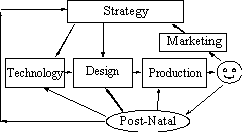

Each expert on product development has a favorite model of the
new product process that emphasizes what he or she thinks is most
important. The above figure illustrates a popular model that separates
technology development from the preparation of designs that production
turns into products or services delivered to customers, all according
to a strategy developed by executives using data on customer needs
and concerns as developed by Marketing and others. This figure
includes one important step that is absent from the processes
recommended by most experts: A project post mortum or "post
natal," which is a powerful tool to help product development
managers decide which of the many different and occasionally conflicting
recommendations should get the most attention. The use of project
post morta and other techniques for prioritizing opportunities
for improvement in a product development process are described
in "Improving the Product Development Process," by Spencer
Graves, Bill Carmichael, Doug Daetz, and Edith Wilson, Hewlett-Packard
Journal, June 1991. For a free copy of this article, contact
Productive Systems Engineering by calling (408)294-5779,
fax: (408)294-2343, or e-mail: sgraves@prodsyse.com.
(You can also order the Journal article directly from
HP. See http://www.hp.com:80/hpj/journal.html.)
Other techniques for diagnosing product development problems are
described in Lightning Strategies for Innovation by Willard
I. Zangwell (NY: Lexington / Macmillan, 1993). A related technique
to help manage product development projects is "The Return
Map", described in an article with this title by Charles
H. House and Raymond L. Price, Harvard Business Review,
69, pp. 92-100, January-February 1991.
Consulting assistance with improving product development is available
from Productive Systems Engineering.
Other Productive Systems Engineering programs: Designed Experiments
(Design of Experiments, DoE or DOX), Reliability Experimentation,
Tolerancing, Quick Start Total Quality
(Total Quality Control, TQC / Total Quality Management, TQM),
Statistical Process Control (SPC); Fiber Optic Communication/Transmission Systems
(FOCS or FOTS); Control and Monitoring
(RMM); Electronics (Theory & Application);
Production Line Assembly for Technicians
(Assembly).
Productive Systems Engineering home page